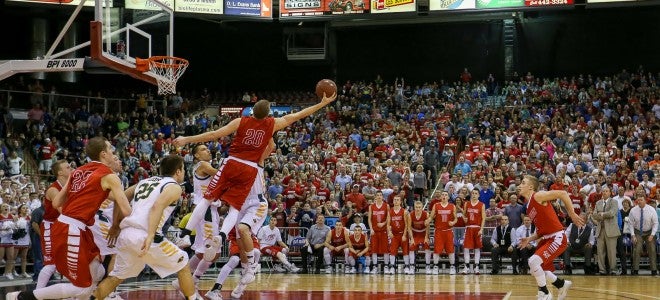

Scott Yenor is Professor of Political Science at Boise State University. He is the author of Family Politics: The Idea of Marriage in Modern Political Thought (Baylor 2011) and Hume’s Humanity: The Philosophy of Common Life and Its Limits (Palgrave 2016).
The Idaho boys high school basketball state tournament last month brought some drama. Fans will long remember the miraculous, buzzer-beating tip-in that catapulted Madison into the championship game and Mason Baker’s clutch three-pointer that led Highland to that Madison match-up and eventual state title. I share other memories too, as my son’s Ambrose Archer team won the 1A Division 1 title, taking out previously undefeated Lapwai with a fourth quarter comeback.
Fans should not confuse drama with high quality play, however. Idaho is, in fact, one of the worst states in which to find quality boys basketball players and teams. While there is no silver bullet to solve this problem, adding a shot clock might help change the regime of Idaho basketball and improve the experience for fans as well as contribute to modest improvements.
THE STATE OF IDAHO BASKETBALL
Division I men’s basketball is a most difficult sport to crack. There are approximately 350 Division I men’s basketball teams that have space for 13 scholarship athletes each, per NCAA rules. That means that about 4,500 players, over a four-year period, play Division I basketball on scholarship. Walk-ons constitute another chunk of players. Compare the basketball numbers to football (123 schools with up to 85 scholarship each): football has about two and a half times more players at the Division I level.
According to the best available statistics, Idaho ranks 47th in producing Division I basketball players in the period from 2008-2013, producing 1 Division I basketball player per 9,984 high school students. Only Hawaii, North Dakota and Rhode Island fare worse. Twenty-three states produce players at rates of 1 per 4,000 or better. Idaho football is far more respectable, ranking 29th on a similar metric, suggesting that it is not high school athletics as such but boys high school basketball that suffers in Idaho.
One can see the same problem by looking at the behavior of the colleges and universities in the state of Idaho. Men’s basketball is, for the most part, still a regional game, as most teams do most of their recruiting in their own states and neighboring states. Atlantic Coast Conference teams recruit mostly in the Southeast. Big Ten schools in the Midwest. Pac 12 schools in the West. This tendency is magnified in the lower divisions of basketball, where NAIA and NCAA Division II and III schools usually recruit from their own neck of the woods for budgetary and time reasons. To illustrate, Westminster College, an NAIA school in Salt Lake, has 12 Utah players on it and Lewis and Clark, a Division III school in Portland, has 4 players from Oregon; Oregon State has couple Oregon kids on it.
Idaho schools had few Idaho kids on them in 2015-2016. NNU, Idaho State and the University of Idaho had zero Idaho kids. Boise State and Lewis & Clark State College had two. College of Idaho had six. College basketball coaches in the area are in a sense voting on the quality of Idaho basketball with their scholarship offers and team slots. More than one coach from outside of Idaho during my son’s own recruiting process has said that it is difficult to trust players from Idaho given the sorry state of the basketball there. “It doesn’t matter if you do badly in Idaho high school basketball,” one said, “and it doesn’t matter if you do well.”
Another way to suggest the problem with Idaho boys high school basketball is to look at scoring. This is a more controversial argument, but it is crucial to my later argument. Defense and hustle cannot of course be forgotten, but the name of the game is put the ball in the hole, as the grumpy denizens of Hickory, Indiana remind the defensive-minded Gene Hackman in Hoosiers. Players must make plays and make shots — not only as the result of set plays but because players make or see opportunities and take them. No greater, more coveted skill exists in basketball than this.
In order to get some apples-to-apples numbers, let us look only at scoring generally. A 2014 study showed that Idaho had the lowest high school scoring average for a winning team (53.3) and the lowest scoring average for a losing team (39.1) in the country.
A more fine-tuned, though not random analysis comes from a study of state tournaments, where the best teams compete, at the highest level. Let us compare Idaho’s 5A 2013-2016 state tournaments to similarly situated states (i.e., rural states) such as New Mexico, Nebraska, Kansas, North and South Dakota and West Virginia at the same level and time. Idaho is like Nebraska, Kansas and New Mexico in that it is a rural state with a biggish metropolitan area (so this band of states should particularly draw our attention), while the other states are just plain rural with few cities over 100,000. West Virginia is the state closest in size to Idaho (ranks 41st in producing Division I men’s basketball players). I combine the scores for both teams to come up with the average points per game in the winner’s bracket in state tournaments at the highest level.
| State | Average Pts./Game |
|---|---|
| ID | 108.18 |
| WV | 121.16 |
| KS | 128.04 |
| NE | 112.5 |
| ND | 128.57 |
| SD | 107.64 |
| NM | 118.54 |
Idaho is nothing if not consistent. It is among the lowest scoring states in the country no matter how the data are sliced. None of these data are sufficiently fine-tuned to provide a scientific argument, of course, and some of the numbers create confusion and cut against my contention (namely that North Dakota scores a lot, but is even worse than Idaho in producing Division I basketball players.) Perhaps North Dakota basketball will improve as time goes on and the state as a whole will be more productive of basketball players.
In any event, the production of basketball players is a long-term project, with most players having to dedicate themselves as early as the 5th or 6th grade. High school is just a not-unimportant finishing touch.
TIME FOR A SHOT CLOCK
High school athletics is one part of an overall education. Athletics should prepare players to win with grace and to lose with dignity; it should teach virtues associated with teamwork, hard work and sportsmanship. Just as math or science curriculum prepares students for college, athletics should also prepare interested and able youth for the next level.
This means that school districts would have some sort of duty to identify coaches who have experience at the college level, or at least know what it takes to make it there. Only about 6 percent of high school basketball players nationwide play at the next level (Idaho’s number is probably around 1 percent), but in this sphere as in so many others it would be best to apply Yenor’s Law of Education: what’s best for the best is best for the rest.
Absent such a regime change in Idaho basketball, there are some rule changes that Idaho could consider to change the approach its coaches take to basketball. Adding a 30 second shot clock is the most important among those changes. Most arguments for the shot clock focus on how that rule change would prevent teams, especially inferior teams, from stalling or that the change would bring increased scoring. Horror stories aplenty exist across the nation and in Idaho about key basketball games decided by players sitting on the ball. Evidence does not yet support the idea that shot clocks bring increased scoring.
My hopes for the shot clock are somewhat broader. Some of the problem with Idaho basketball is that players are not encouraged to make and seek out opportunities for scoring. Again, examples abound, but here is what I have in mind. A screener on an inbounds play is unguarded four feet from the basket and he vacates his spot to set the screen demanded by the inbounds play. A screener sets a down screen and his defender hedges against the shooter for whom he is setting the screen: neither the passer nor the now unguarded screener looks for the slip. Defenses have it pretty easy when teams simply run their sets, because they know where each player is going and what that player’s job is.
Each player is currently doing his job and running the set, but few are taking advantage of or making their own opportunities for scoring. Seeking out opportunities is a means of building basketball intelligence in both the defense and the offense. Offensive players would have to read the defense, defensive players would not be able to simply anticipate other teams’ sets but learn to identify and defend the “important” area or man on each play, and coaches would have to teach or at least help to reinforce these particular skills if they would want to get good looks at the basket or get stops.
Coaches would also be more inclined to focus on player development instead of “learning the offense” as the concept is currently understood in boys high school basketball. Bigs would need to learn more shooting instead of just getting the ball into the post, guards might practice posting up when they have an advantage. All would be encouraged to handle the ball, set timely screens, dribble, penetrate when it is open or to take risks and make shots.
Since teams currently have an unlimited amount of time, they can run their sets without making and taking these opportunities. Limiting the amount of time would probably change the way many coaches coach — and this might have the effect of preparing more players for playing at the next level.
Seven states have a shot clock for boys high school basketball (California, New York, Massachusetts, North Dakota, South Dakota, Rhode Island and Washington). None of these states rank among the highest in per student Division I players: California is 35th, New York 29th, Massachusetts 42nd, North Dakota 49th, South Dakota 23rd, Rhode Island 48th and Washington 31st). This hurts my argument. Certainly if one were to compare Washington to Idaho basketball, one would see more than a little evidence for my position with the eye test. In any event, the lion will not be laying down with the lamb if we adopt the shot clock. My position is kind of a tragic one: it could hardly get worse for basketball in Idaho and the shot clock would, at the least, shake things up and might make things better.
REGIME CHANGE
There would be costs and consequences to such a change. Monetary costs would range from $2K per school to install the shot clock and the need to hire a clock operator for all home games. There would also be costs to the Idaho High School Athletic Association, which would lose the ability to serve or vote on the National Federation of High School’s rules committee.
Perhaps Idaho could conduct an experiment, where larger schools adopt the shot clock for a term and then the question is revisited for the state. In any event, the shot clock would move the needle in a positive direction for Idaho basketball. It might encourage coaches to adapt and to coach the whole player. It might improve the ability of student athletes to read, react and improve. The shot clock is an element of what is needed: a state improvement plan for boys high school basketball.